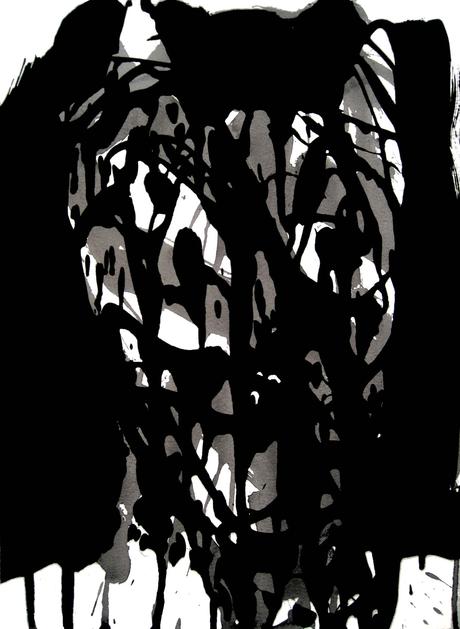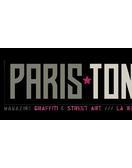Down by law – une satire fascinante
La coulure en temps que technique de peinture représente des politiciens corrompus dans la série Down by law, « elle s’autonomise et dérègle le régime classique du signe[1]». Entre lois physique et lois législative, la série Down by law exprime l’organisation du monde avec ses processus créatifs basés sur les lois universelles de la gravitation et les lois juridiques organisant la vie dans la polis. La peinture de Fasim synthétise les éléments essentiels de la vie qui parcourent la cité. Une cité qu’il explore comme le lieu vivant où la performance du writing vient à dépeindre la vie dans la ville, sur sa peau et nourrissant sa pratique plus traditionnelle d’atelier.
La coulure fait partie du vocabulaire artistique : les larmes (Pieter Von Mol, Déposition, vers 1635), le sang (Fra Angelico, Saint Dominique avec le Christ en croix, vers 1941), l’eau (Lucas von Valckenborch, L’hiver, vers 1595), qui jaillit avec Francis Bacon (Jet d’eau, 1979), ou Jeff Wall (Milk, 1984), la peinture (Roy Liechtenstein, Brushstroke, 1965), elle devient le sujet central dans l’œuvre de Jackson Pollock, et Cy Twombly l’oppose aux aplats de pinceau dans Untiltted (Rose) en 2008. La coulure devient avec l’utilisation des aérosols et des marqueurs, la nouvelle conquête du peintre. Peindre avec un aérosol nécessite de pouvoir maîtriser le flot de peinture, ce à quoi s’exerce Fasim depuis sa rencontre à Barcelone en 1986 avec Henry Chalfant. La coulure est censurée ou exploitée dans l’esthétique du writing dont l’esprit imprègne le street art. Fasim inscrit la coulure dans la tradition de la peinture espagnole dont il renouvelle le style. Les facettes cubistes des portraits de Picasso, les montres de Dali, sont métamorphosées en coulées chez Fasim. Il s’empare de ce vocable pictural qui traverse l’histoire de la peinture pour réaliser les portraits de politiciens corrompus de la série Down by law. Ces figures du pouvoir coulantes rappellent les épanchements qui s’écoulent des saintes plaies de cette autre figure du pouvoir qu’est le Christ (Rogier Van der Weyden, Crucifixion, vers 1425-1430, Fra Angelico, Crucifixion, vers 1430, Véronèse, Pieta, 1581). La monarchie espagnole, son déclin, la dictature franquiste, la Movida, la monarchie constitutionnelle, le bi-partisme sont autant d’éléments fort de l’histoire qui peuplent l’espace culturel d’une Espagne en pleine mutation et forment des tresses avec les traditions catholiques, royalistes et les héritages démocratiques gréco-romain. Tout cela vient se glisser entre les vides et les pleins des œuvres de Fasim, et finissent par déborder, ivre du désir de la liberté.
La série Down by law libère le discours des formes académiques et entraîne cette dialectique ruisselante à faire jaillir l’épouvante contenue dans les œuvres des politiciens corrompus inondant la cité qu’il a choisit de peindre et dépeindre. Il y a dans la coulure la brutalité de la sensation manifestée qui n’est pas encore conscientisée. Elle exprime cette sensation reçue, tend à faire apparaître un langage archaïque, sensitif. Elle représente le mouvement, l’instabilité, l’évolutif, elle incarne la vie, le doute, elle s’oppose aux dogmes stables et rigides. Les coulures de la série Down by law offrent un espace entre l’épouvante qu’elle convoque et l’assainissement par la liquidité, comme si ces portraits de politiciens décadents pouvaient dégouliner jusqu’à disparaître de la scène politique.
Cette satire picturale représente le pilonnage des politiciens immoraux en 2018 en Espagne, comme la Guernica peut représenter le bombardement ordonné par les nationalistes espagnols en 1937, elle invite à la réflexion par la dénonciation. L’art « possède une force d’éveil prophétique qui peut avoir une profonde influence[2]» appel au changement avec la série Down by law de Fasim.
[1]La coulure. Histoire(s) de la peinture en mouvement, Paris, éd.. Hazan, 2015, p. 95.
[2]Wassily Kandinsky, Du spirituel dans l’art, et dans la peinture en particulier, Paris, éd. Denoël, coll. « Folio », 1989, P. 58.
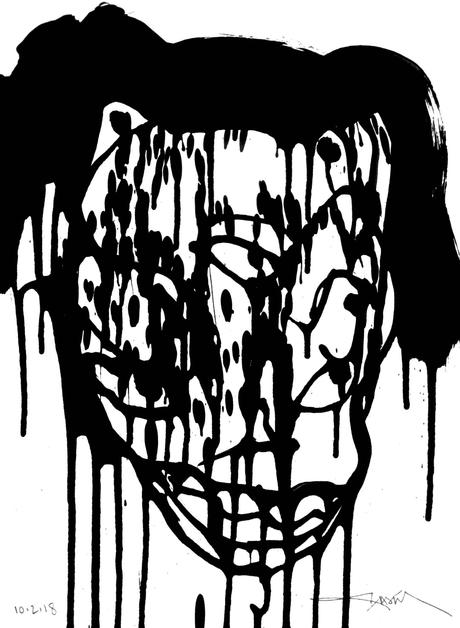
Down by law – A fascinating satire
Dripping as a pictorial technique represents corrupt politicians in the series Down by Law, « it be-comes self-sufficient and disrupts the classical regime of the sign”.
Between physical laws and legislative laws, the Down by Law series expresses the organisation of the world with its creative processes based on the universal laws of gravitation and the legal laws organising life in the polis.
Fasim’s painting synthesises the essential elements of life that run through the city. A city he explores as a living place where the performance of writing comes to depict life in the city, on his skin and nourishing his more traditional workshop practice.
Dripping is part of the artistic vocabulary: present as tears (Pieter Von Mol, Deposition, around 1635), as blood (Fra Angelico, Saint Dominic with Christ on the cross, around 1941), as water (Lucas von Valckenborch, Winter , circa 1595), which springs with Francis Bacon (Jet d’eau, 1979), or Jeff Wall (Milk, 1984), as paint (Roy Liechtenstein, Brushstroke, 1965); it becomes the central subject in Jackson’s work Pollock, and is opposed to brushstrokes in Cy Twombly’s Untiltted (Rose) in 2008.
With the use of aerosols and markers, dripping becomes the new conquest of the painter. To paint with an aerosol requires to control the flow of paint, which Fasim has been doing since meeting Henry Chalfant in Barcelona back in 1986. Dripping is censored or exploited in the aesthetics of writing, whose spirit permeates street art.
Fasim inscribes dripping in the tradition of the Spanish painting, of which he renews the style: the cubist facets of Picasso’s portraits and Dali’s watches morph into drips in his work. He makes this pictorial term that runs through the history of painting his own to portray corrupt politicians in the series Down by Law. These figures of power recall the effusions leaking from the holy wounds of this other figure of power that is Christ (Rogier Van der Weyden, Crucifixion, around 1425-1430, Fra Angelico, Crucifixion, around 1430, Veronese, Pieta , 1581).
The Spanish monarchy, its decline, Franco’s dictatorship, the Movida, the constitutional monarchy, the bi-partidism are all strong elements of history that populate the cultural space of a country, Spain, immersed in transformation, and that link with Catholic, Royalist and Greco-Roman democratic inheritances.
All these slide and pour between the gaps and the shapes of the works of Fasim, and end up overflowing them, drunk with desire for freedom.
The series Down by Law frees the discourse from academic forms and leads this dripping dialectic to expose the contained terror that lies in the corrupt politicians’ works scattered across the city he chose to paint and depict. In the dripping lies the brutality of the manifested sensation which is not yet conscious. It expresses this received sensation and tends to reveal an archaic, sensitive language.
It represents movement, instability, evolution, it embodies life, and doubt; it opposes stable and rigid dogmas.
The drips of the Down by Law series offer a space between the horror it conjures up and the cleansing through liquidity, as if these decadent politicians portrayed could leak and drip away to the point of disappearing from the political scene.
This pictorial satire represents the constant bombarding of politicians’ immorality in 2018 in Spain, as the Guernica can represent the bombardment ordered by the Spanish nationalists in 1937, and it invites reflection through denouncement. Art « has a prophetic awakening power that can have a profound influence » .
Fasim’s Down by Law series calls for change.
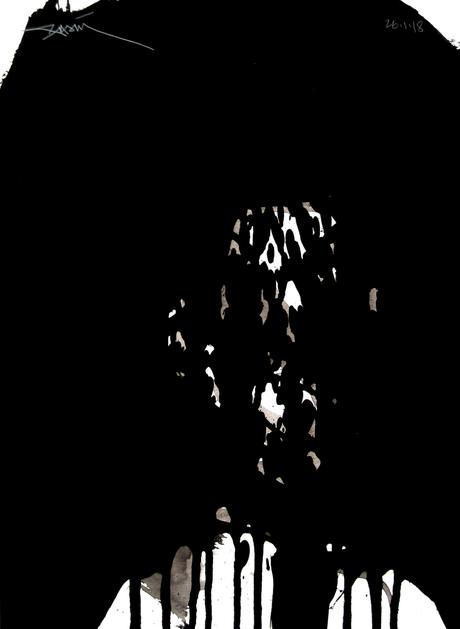
LINEA6 Backstore, C/ Ample de la Mercè, 20, Palma de Mallorca, 07002, Baleares. https://linea6.com/
From May 4 and up to the beginning of August you can visit the individual exhibition of the Barcelona artist Germán Bel / Fasim in the small gallery of Linea6 Backstore in Palma de Mallorca entitled; ‘Down By Law, Works on paper, 2018’.
The title refers to the series of paintings on paper painted in rigorous black acrylic that the artist has been developing for about a year and the series has not yet concluded, Fasim clarifies; « I’ve painted around 180 until now, but I have not yet cataloged them all, only about 50 or so, I do not all like them either, but I have not bored myself and the series promises to get longer, new paintings keep coming out every day, I want to see how far arrive. »
The series has never been shown to the public and a selection of nine original paintings on paper from the Down by Law series is presented for the first time, four of which are dedicated to corrupt politicians, on this point and on the selected series of paintings. graffiti writer and painter Lady K 156 / Jessica Balota has written a text for the occasion.
The show is complemented by two numbered serigraphs, one of the same series as the exhibition.
The exhibition hall is exhibiting artists since July 2016, date of its inauguration and artists such as Dems333, Egs or Xena among others have already passed.
If you are going to visit Mallorca this summer you can not miss the opportunity to visit this unique exhibition.
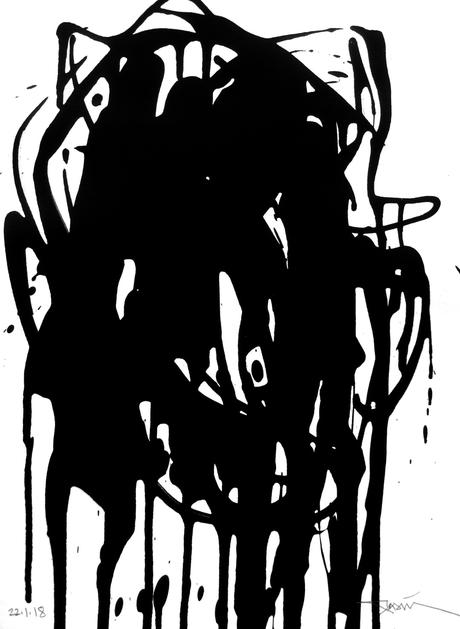
Down By Law – Una sátira fascinante.
« El goteo como técnica pictórica representa a políticos corruptos en la serie Down By Law, que «es autosuficiente y desbarata el sistema clásico del signo».
A caballo entre las leyes físicas y las legislativas, la serie Down By Law versa sobre los procesos creativos basados en las leyes universales de la gravedad y en las leyes jurídicas establecidas para la vida en la polis.
La pintura de Fasim sintetiza los elementos esenciales de la vida que forman parte de la ciudad. Una ciudad que explora como lugar vivo, donde los textos rotulados retratan la vida urbana, sobre su piel y nutriendo su trabajo más tradicional de estudio.
El goteo forma parte del vocabulario artístico: lágrimas (Pieter van Mol, Descendimiento, hacia 1635), sangre (Fra Angelico, Santo domingo, adoración del Crucificado, hacia 1941), agua (Lucas van Valckenborch, Invierno, hacia 1595; Francis Bacon, Chorro de agua, 1979), leche (Jeff Wall, Leche, 1984), pintura (Roy Liechtenstein, Pincelada, 1965). El goteo se convierte en el motivo central de la obra de Jackson Pollock. Por el contrario, Cy Twombly lo contrapone a manchas de colores planos (Sin título, Rosa, 2008).
El goteo es el nuevo territorio pictórico a conquistar, junto con el uso de los botes de espray y los rotuladores. Pintar con espray exige dominar el chorrear de la pintura, algo que Fasim ha estado practicando desde que conoció a Henry Chalfant en Barcelona en 1986. El goteo se suele censurar o se usa como estética grafitera; en toda su esencia rezuma arte callejero.
Fasim ha logrado introducir el goteo en la tradición pictórica española y revitalizar el estilo. Fasim transforma en goteos los elementos cubistas de los retratos de Picasso o los relojes de Dalí.
Fasim se apropia de este vocabulario pictórico que recorre la historia de la pintura para realizar los retratos de políticos corruptos de la serie Down by Law. Estas figuras del poder que gotean recuerdan a las efusiones que se derraman de las llagas sagradas de esa otra figura del poder que es Jesucristo (Rogier Van der Weyden, Crucifixión, hacia 1425-1430, Fra Angelico, Crucifixión, hacia 1430, Véronèse, Pieta, 1581).
La monarquía española y su decadencia, la dictadura franquista, la movida, la monarquía constitucional o el bipartidismo son potentes elementos históricos que pueblan la cultura española en plena mutación, y que enlazan con las tradiciones católicas, monárquicas y la herencia democrática grecorromana.
Todo ello se desliza entre los vacíos y los llenos de las obras de Fasim y acaba por desbordarse, embriagado de anhelo de libertad.
La serie Down By Law libera el discurso de las formas académicas y da pie a una dialéctica chorreante que suscita el terror repentino contenido en sus pinturas de políticos corruptos que inundan la ciudad que él ha elegido pintar y describir. En el goteo se halla la brutalidad de la sensación manifestada de la que todavía no se tiene consciencia. En él se expresa esa sensación recibida, y tiende a hacer aparecer un lenguaje arcaico, sensitivo.
El goteo significa movimiento, inestabilidad, evolución, vida, duda y se opone a los dogmas estables y rígidos.
Los goteos de la serie Down By Law sugieren un espacio entre el espanto que evocan y la purificación a través de la fluidez, como si esos retratos de políticos decadentes pudieran irse escurriendo hasta desaparecer de la escena política.
Esta sátira pictórica representa el bombardeo de políticos inmorales en España en 2018, como el Guernicapuede representar el bombardeo ordenado por los nacionales españoles en 1937; invita a la reflexión a través de la denuncia.
Las obras de Fasim en Down By Law son una llamada al cambio.
